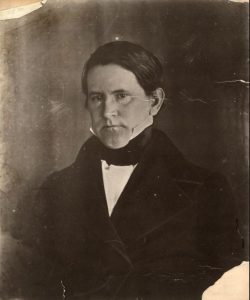
Photo info ...
Credit: Indiana Historical SocietyView Source
(Apr. 4, 1799-Sept. 4, 1859). David Wallace was born in Mifflin County, Pennsylvania, to Andrew and Eleanor Wallace. Wallace’s father developed a close friendship with former governor of the Indiana Territory (1800-1812) and future U.S. president, William Henry Harrison, when the two served together in the War of 1812. The Wallace family would enjoy the benefits of Harrison’s patronage through political appointments for decades.
Wallace’s family moved to Ohio during his youth. He attended Miami College before his family relocated to Brookville, Indiana, in 1817. Harrison, at this point a U.S. Representative of Ohio, secured Wallace’s entry into the U.S. Military Academy at West Point. Wallace graduated with the rank of second lieutenant in 1821. He taught mathematics at the academy for one year and later served as a captain and colonel in the Indiana Militia.
After leaving the military, Wallace returned to Brookville, where he studied law and was admitted to the bar in 1823. He joined the law practice of Congressman John Test and married Test’s daughter Esther on November 10, 1824. They had four children, notably Civil War general and author . After Wallace’s wife died in 1834, he married temperance and suffrage activist in 1836, with whom he had six children.
Wallace served in the Indiana House of Representatives from 1828 to 1831. He served as lieutenant governor on the Whig ticket with Noah Noble from 1831 to 1837. Wallace led the debate to create the in 1833 and strongly advocated for the Mammoth Internal Improvement Act in 1836. The latter project added $10 million in funding for turnpikes, canals, and railroads and provided the major platform for Wallace’s bid for the governorship of Indiana in 1837.
Wallace moved his family to Indianapolis in 1837. Though Wallace won his bid for governor, his administration was plagued with economic disaster stemming from the expenses for the state’s internal improvements and the Panic of 1837. Wallace staved off the state’s insolvency by halting work on the internal improvements project. However, by the end of his term, interest on the massive $10 million debt proved insuperable and the state’s credit had been exhausted.
In 1838, Wallace ordered the removal from Indiana of the last Native Americans who lingered in the state past the signing of the 1833 Treaty of Chicago with the Potawatomi. Of the 859 Potawatomi removed from the state, 42, mostly children, died from disease and stress related to the two-month walk to the Kansas Territory, known as the “Trail of Death.”
Denied a spot on the Whig ticket for reelection as governor, Wallace returned to his law practice at the end of his term. The Indianapolis district elected him to the U.S. House of Representatives in 1841, where he advocated for federal spending to develop the telegraph. Defeated in his bid for reelection, Wallace returned to Indiana where he became chairman of the Whig Party in 1846. He served as Indianapolis delegate to the state’s Constitutional Convention in 1851 and as a judge of the Court of Common Pleas of Marion County from 1856 to the time of his death. Wallace was buried at .

Help improve this entry
Contribute information, offer corrections, suggest images.
You can also recommend new entries related to this topic.